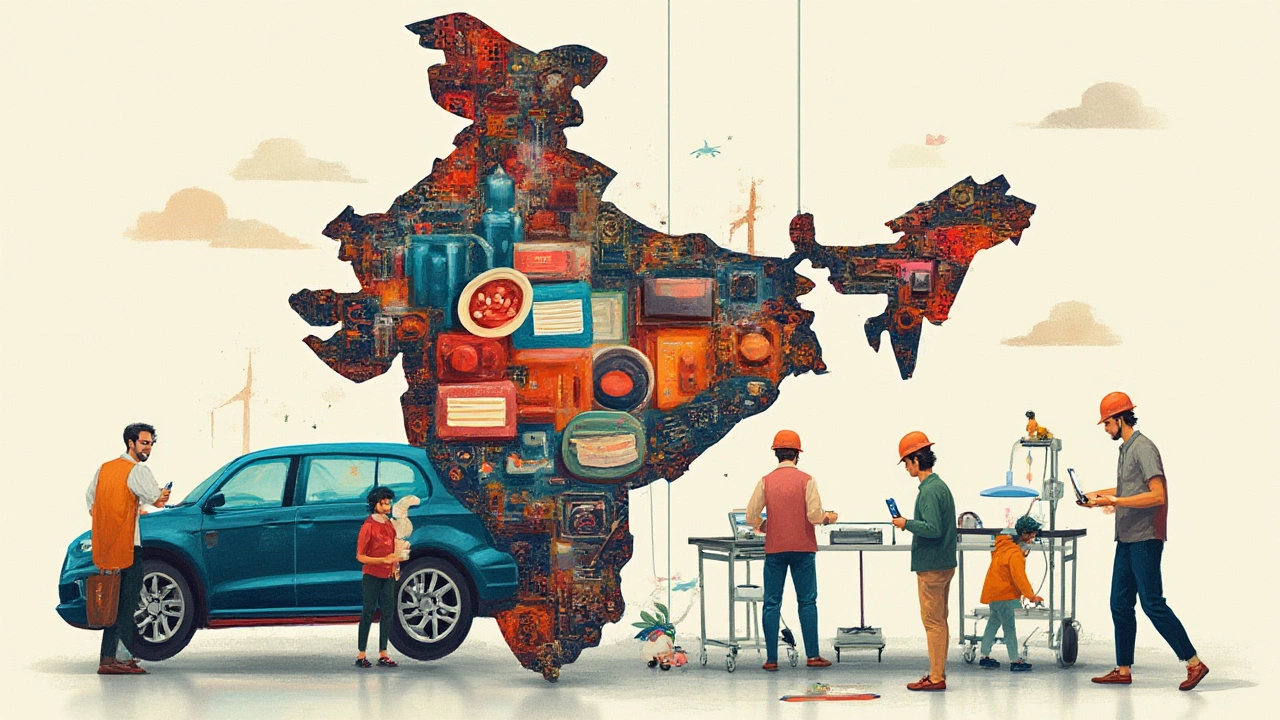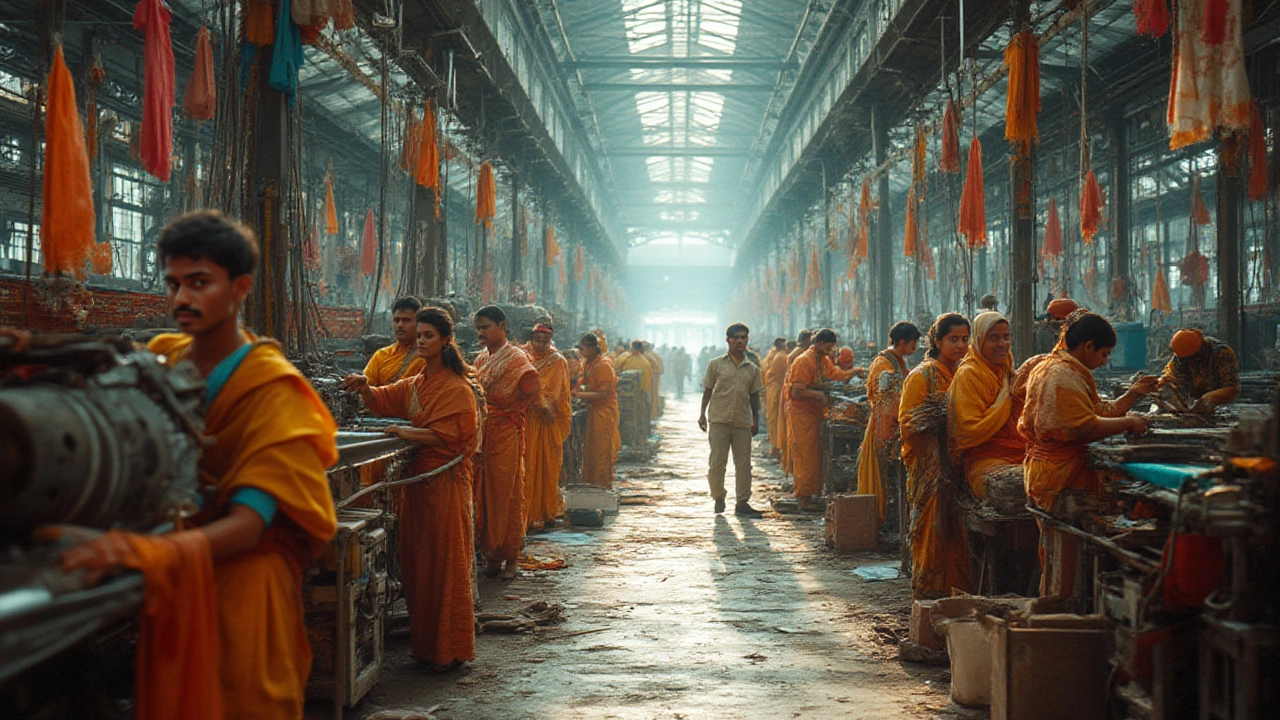If you think India is just cricket, curry, and crowded streets, you're missing the real story. Behind the buzz and color of daily life lies a manufacturing powerhouse—the fifth largest in the world, as of 2024. Everywhere you look, from smartphones to scooters, cotton shirts to cancer drugs, something stamped 'Made in India' is quietly shaping global markets. So many people ask: what does India actually manufacture the most? The answers might surprise you, and the numbers are genuinely eye-opening.
Textiles: The Fabric Woven Into Everyday Life
Take a quick look in your wardrobe. Odds are, at least one label says 'Made in India.' The textile industry is practically woven into Indian identity, and not just because it keeps millions employed—some estimates put it north of 45 million jobs directly and twice that in related sectors. India's textile legacy is older than the Taj Mahal, yet it's anything but stuck in time. Walk through a fabric bazaar in Mumbai or Delhi, and you'll see sarees, shirts, towels, even designer denim destined for Paris or New York. About 12% of the world’s textile and apparel exports actually come from India, with cotton and manmade fibers topping the charts.
No other country produces more cotton after China. In 2022–2023, Indian farmers harvested nearly 6.3 million metric tons. That cotton doesn't just stay domestic: Bangladesh, Vietnam, and Turkey buy up huge bales to keep their own factories humming. After cotton, India's silk and jute industries are heavy hitters. The country churns out more raw jute than anyone but Bangladesh and leads globally in the production of raw silk outside China. Combined, these sectors feed local garment giants and export pipelines with billions in annual sales.
Curious about where all this fabric goes? Table linens, home textiles, denim wear, and T-shirts are top sellers in markets like the US, UK, UAE, and Germany. The flexibility of Indian textile mills means they’ll do everything from bulk basic tees to luxury embroidery for high fashion. Smarter processes, like adding value through cutting-edge dyeing and eco-friendly fabrics, have kept India relevant as global fashion shifts towards sustainability.
Here’s a snapshot of Indian textile exports (2022-2023):
| Product | Value (USD Billion) |
|---|---|
| Garments | 16.2 |
| Cotton Textiles | 11.1 |
| Manmade Textiles | 5.2 |
| Jute Products | 0.35 |
It’s not just about old looms and hand-spun cloth. India is going big on technical textiles—think flame-resistant uniforms, filtration fabrics, car seat covers. As the world's demand shifts, Indian mills have shown they can pivot, blending tradition and tech. If you’re thinking about business, tech-driven apparel and eco-fabrics are the hot tickets.
Automobiles and Engineering: Gearing Up for the World
Try crossing an Indian street and you’ll get a crash course in just how many wheels India churns out—two-wheelers, three-wheelers, compact cars, even giant trucks. Last year, India surpassed Japan to become the third-largest car market globally after China and the US. But here's the kicker: about half the world’s motorcycles are made in India, with brands like Hero MotoCorp, Bajaj, and TVS selling millions each year across Asia, Africa, and Latin America.
The boom isn’t limited to two-wheelers. Tata Motors and Mahindra are ramping up electric cars and trucks for both local and European markets. India's automobile industry now supports more than 37 million jobs, if you count everyone from auto-parts suppliers to the guys welding frames together. And they’re not just building for themselves. Indian car manufacturers exported over 6.5 million vehicles in 2023, shipping out everything from tiny hatchbacks to rugged utility vehicles.
Of course, it’s not all cars and bikes. India produces a massive range of auto components—engine parts, tires, batteries—which end up in assembly lines from Detroit to Dakar. The engineering sector also churns out precision machinery, tractors (India is world #1), pumps, fans, and heavy equipment. When Audi, BMW, or Caterpillar want engine castings at scale, more often than not, Indian foundries deliver.
Want proof? Here’s a table of export totals (2022-2023):
| Category | Value (USD Billion) |
|---|---|
| Automobiles | 8.7 |
| Auto Components | 6.3 |
| Engineering Goods | 110.1 |
India is also leading a quiet electric revolution. By 2030, over 30% of all new vehicles sold in India are expected to be electric, up from just under 2% today. This massive shift means huge bets on battery manufacturing, power electronics, and the factories behind charging stations. Good time to keep an eye on Indian tech and battery startups.

Pharmaceuticals and Chemicals: The Pharmacy for the World
If you or someone you know takes generic medication, chances are it’s made in India. Nicknamed ‘The Pharmacy of the World,’ India supplies over 20% of global generic medicines by volume. That's seriously impressive, considering the country’s pharma sector was barely a blip a few decades ago. Now, it’s a $50 billion industry (2023) exporting to more than 200 countries, with the US, UK, and Russia as top customers.
The secret isn’t just in low costs. Indian pharma firms like Sun Pharma, Dr. Reddy’s, and Cipla invest heavily in R&D, clinical trials, and regulatory compliance, pushing out everything from antibiotics to complex cancer drugs and vaccines. Back in 2021, India supplied 60% of the world’s demand for COVID-19 vaccines, shipping more vials overseas than almost anyone. Those little white pills on pharmacy shelves in Auckland or London? They’re as likely as not to be stamped with an Indian manufacturer’s code.
The numbers back it up:
| Product | Value (USD Billion, 2022-23) |
|---|---|
| Pharmaceuticals | 25.4 |
| Chemicals (organic, inorganic, fertilisers) | 29.2 |
Chemicals are another pillar. From fertilizers and industrial acids to specialty chemicals for electronics, paint, and food-processing, Indian plants stand tall among global suppliers. R&D hubs are not just sticking to copycats—they’re ahead in producing ‘biosimilars’ (cheaper versions of biotech drugs) and green chemicals. India’s expertise is so respected that China increasingly relies on Indian active pharmaceutical ingredients (APIs) when their own supply chains get rocky.
Quoting The Lancet, a leading medical journal:
“India’s pharmaceutical exports play a vital role in making medicines affordable, with generics accounting for 70% of World Health Organization essential drug purchases.”
India’s health might be complicated, but its medicines have a global reputation for reliability and affordability.
Electronics, IT Hardware & the Surprising High-Tech Push
Now for the wild card: electronics. Twenty years ago, electronics manufacturing in India meant simple gadgets and cheap TV circuit boards. By July 2025, it’s a whole different ballgame. India is now the world’s second-biggest producer of mobile phones, manufacturing more than 330 million units in 2023. Apple assembly lines in Chennai and Bengaluru crank out iPhones for Europe and the US, while Samsung and Xiaomi keep shelves stocked across Africa and the Middle East.
All that wasn’t inevitable. The Indian government’s ‘Make in India’ initiative, along with hefty investment by tech giants, is driving the change. Multipurpose factories now produce millions of televisions, laptops, and wearable gadgets every year. Exports of electronics rose above $23.6 billion in 2023—a sixfold jump in just eight years. Right now, you might be reading this on a device at least partly made by Indian hands.
Semiconductor dreams are big. India is building its first world-class fab (chip plant) outside Gujarat. If the plans pan out, Indian-made chips will soon power everything from cars to smartwatches. IT hardware, routers, battery packs, and even solar panels are rolling off production lines, making India more self-reliant and less dependent on China.
Here’s that high-tech surge in numbers:
| Product | Value (USD Billion, 2022–23) |
|---|---|
| Mobile phones | 15.1 |
| Electronics (overall) | 23.6 |
| Computer hardware | 6.2 |
If you’re an entrepreneur, the good news is many state governments offer tax breaks, easy loans, and land specifically for electronics factories. By 2027, the sector expects to double in size again. Anyone thinking of importing, exporting, or starting up has serious opportunities here.
If you zoom out, it’s clear that India isn’t just making things for cheap anymore. Whether it's a cotton sari, a generic medicine, a Tata electric car, or the latest smartphone, it's about quality, scale, and technology all rolled into one. The backbone of India's growth has been its adaptability—blending ancient crafts with next-gen innovation, labor power with technical brains. That unique mix is what keeps 'Made in India' products flooding the world markets, surprise after surprise. One thing’s for sure—no matter where you’re standing, chances are something nearby has roots in an Indian factory.
